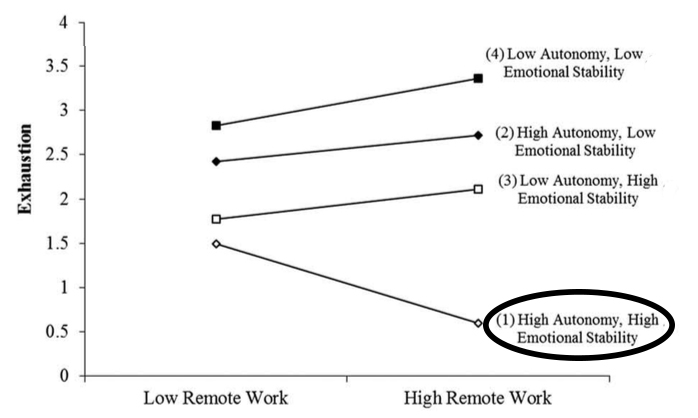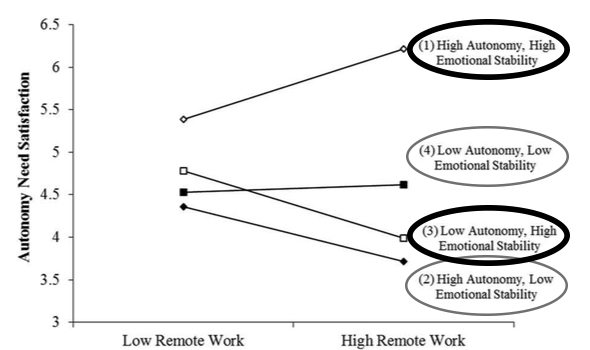Out of Office: What Type of Employee is Best Suited for Remote Work?
Sara Jansen Perry, PhD, Cristina Rubino, PhD, and Emily M. Hunter, PhD
 Many U.S. employees believe working from home—or at least away from the office—can bring freedom and stress-free job satisfaction. But our recent research says, “Not so fast.” Our study, published recently in the European Journal of Work and Organizational Psychology, examines the impact of remote work on employee well-being and offers several strategies to help managers provide remote-work opportunities that are valuable to all types of employees and the company.
Many U.S. employees believe working from home—or at least away from the office—can bring freedom and stress-free job satisfaction. But our recent research says, “Not so fast.” Our study, published recently in the European Journal of Work and Organizational Psychology, examines the impact of remote work on employee well-being and offers several strategies to help managers provide remote-work opportunities that are valuable to all types of employees and the company.
Popularity of Remote Work
Remote work (i.e., performing work at a location other than one’s primary office) is one form of flexibility that is highly valued by many employees and often used by organizations to attract high quality applicants (Allen et al. 2012; Humphrey, Nahrgang, & Morgeson 2007; Thompson et al. 2015). In their most recent study, the Society for Human Resource Management (SHRM 2017) found that 59% of 2,700 firms across industries offer employees the opportunity to work remotely on an ad-hoc basis, up from 54% in 2014. Twenty-three percent of firms offer full-time remote work arrangements, and 35% offer part-time arrangements. This shift suggests that people and organizations find value in remote work, begging the question: how does the extent to which one engages in remote work impact well-being? The conclusion from over a decade of empirical research on the linkage between remote work and well-being is, “it depends” (e.g., Gajendran & Harrison 2007). Because working remotely impacts the physical, social, and psychological context of work, more extensive remote work can be depleting due to the challenges it presents and resources it consumes (e.g., time spent coordinating with others, managing ambiguity, or managing non-work stressors, loss of socio-emotional support), causing increased strain (Sewell & Taskin 2015). Despite the challenges, however, remote work also stimulates employees by offering important benefits, leading to increased motivation, satisfaction, and commitment, and reduced turnover and work-family conflict (Gajendran et al. 2015; Golden 2006a; Rousseau, Ho, & Greenberg 2006).
Demand-Control Model: Autonomy and Strain in Remote Work
We aim to contribute to this line of work by untangling the independent and interactive effects of the extent to which an employee works physically away from the primary office (ranging from none to full-time) and the job autonomy (i.e., discretion, a form of control) available to employees. Autonomy is a valuable resource across jobs that helps employees avoid strain, and it is particularly critical in remote work (Gajendran & Harrison 2007). Although workers may perceive they have greater autonomy given their flexibility in choosing where they work, they may still have limited autonomy regarding how they accomplish tasks. The level of autonomy can vary based on job level (e.g., manager versus team member) and across employers, as some employers provide more specific and detailed task requirements, performance standards, and electronic monitoring processes when employees work remotely compared to on-site workers (Ambrose & Adler 2000).
Strain, a diminished state of well-being, is the outcome of interest in this study, and we examine three forms: exhaustion, disengagement, and dissatisfaction. Because remote work can be challenging in addition to its benefits, we position remote work as a possible job demand leading to strain, if not used in the proper way. The Demand-Control (D-C) model proposes that job demands and control (i.e., autonomy) interact to predict strain, wherein individuals who experience high demands with little personal control will experience the most negative health consequences (Karasek 1979).
Demand-Control-Person Model: Emotional Stability as Moderator
Emotional stability captures how even-keeled someone is or, on the opposite end, how malleable their emotions are. If something stressful happens at work, a person who is high on emotional stability would take it in stride, remain positive, and figure out how to address it. A person low on emotional stability might get frustrated and discouraged, expending energy with those emotions instead of on the issue at hand. We expect that individuals with lower levels of emotional stability will experience higher levels of strain as the extent of remote work increases, regardless of their level of job autonomy, because they are either unaware of the existence or utility of this resource, or they perceive it as an additional threat, burden of responsibility, or need for accountability (Rubino et al. 2012). In contrast, individuals with high levels of emotional stability can capitalize on the benefits of job autonomy as a resource, which may become more important as the extent of remote work increases (Kammeyer-Mueller et al. 2016).
Need Satisfaction as Mediator
One reason these factors are important in predicting strain is because they impact the degree to which basic needs for autonomy, relatedness, and competence are met, as predicted by Self-Determination Theory (SDT; Deci & Ryan 2000). First, the innate need for autonomy is not necessarily satisfied when employees work remotely; we directly test the link as we examine joint effects of the extent of remote work and emotional stability. Second, relatedness need satisfaction is relevant because isolation is the most common concern when employees work remotely (Belle, Burley, & Long 2015; Thatcher & Zhu 2006). Finally, competence need satisfaction refers to how effective persons feel in interacting with their environment and in applying their own abilities toward achieving goals (Chiniara & Bentein 2016). Employees who work remotely do not receive as much feedback, coaching, or encouragement from others, have less visibility among coworkers, and cannot as easily compare their own abilities with their peers (Sewell & Taskin 2015). Thus, we posit that extent of remote work is negatively associated with all three types of need satisfaction among all combinations of autonomy and emotional stability, except when autonomy and emotional stability are both high.
Findings
We studied a total of 403 working adults in two separate studies. We measured each employee’s autonomy, strain, and emotional stability. In short, our research has two key findings:
 Autonomy is critical to protecting remote employees’ well-being and helping them avoid all three forms of strain, but emotional stability is also a requirement for autonomy to have optimal effect in reducing strain in remote work (see figure to right as exemplar). This effect is partly explained by autonomy, relatedness, and competence need satisfaction. Overall, employees reporting high levels of autonomy and emotional stability appear to be the most able to thrive in remote-work positions, by having these needs met and experiencing better well-being.
Autonomy is critical to protecting remote employees’ well-being and helping them avoid all three forms of strain, but emotional stability is also a requirement for autonomy to have optimal effect in reducing strain in remote work (see figure to right as exemplar). This effect is partly explained by autonomy, relatedness, and competence need satisfaction. Overall, employees reporting high levels of autonomy and emotional stability appear to be the most able to thrive in remote-work positions, by having these needs met and experiencing better well-being. Employees with lower levels of emotional stability actually have lower need for autonomy (see figure to right). As the black circles indicate, employees with high emotional stability best meet their need for autonomy when they both work remotely and have high autonomy. Following a completely different pattern, as indicated by the gray circles, employees with lower emotional stability and lower autonomy also meet their need for autonomy moderately well, regardless of the extent to which they work remotely. In contrast, these less emotionally stable employees with high autonomy experience more detrimental effects as they work remotely more often.
Employees with lower levels of emotional stability actually have lower need for autonomy (see figure to right). As the black circles indicate, employees with high emotional stability best meet their need for autonomy when they both work remotely and have high autonomy. Following a completely different pattern, as indicated by the gray circles, employees with lower emotional stability and lower autonomy also meet their need for autonomy moderately well, regardless of the extent to which they work remotely. In contrast, these less emotionally stable employees with high autonomy experience more detrimental effects as they work remotely more often.
What it Means
Interestingly, this work contradicts past research that says autonomy is a universal need that everyone possesses, suggesting that employees who are lower in emotional stability may not need or want as much autonomy in their work. This lower need for autonomy may explain why less emotionally stable employees don’t do as well when working remotely, even when they have autonomy.
We offer several recommendations for managers who design or oversee remote-work arrangements, particularly those in the real estate industry, which features a high degree of remote work and autonomy among agents, but less among office staff. Most importantly, we first suggest managers look at employee behaviors when deciding who should work remotely; if someone does not handle stress well in the office, they are not likely to handle it well when working remotely either.
However, if less emotionally stable individuals must work remotely, managers should take care to provide more resources, other than autonomy, including support to help foster strong relationships with coworkers and managers. Managers should also consider providing proper training and equipment for remote work, including proper separation of work and family spaces, clear procedural and performance expectations, and regular contact (virtual or face-to-face) with coworkers and managers.
. . . . . . . . . . . . . . . . . . .
Recommended Reading
Perry, Sara Jansen, Cristina Rubino, and Emily M. Hunter (2018), “Stress in Remote Work: Two Studies Testing the Demand-Control-Person Model,” European Journal of Work and Organizational Psychology, 27(5), 577–593. doi: 10.1080/1359432X.2018.1487402
. . . . . . . . . . . . . . . . . . .
References
Allen, Tammy D., Ryan C. Johnson, Kaitlin M. Kiburz, and Kristen M. Shockley (2012), “Work-Family Conflict and Flexible Work Arrangements: Deconstructing Flexibility,” Personnel Psychology, 66, 345–376.
Ambrose, Maureen L. and G. Stoney Adler (2000), “Designing, Implementing, and Utilizing Computerized Performance Monitoring: Enhancing Organizational Justice,” Research in Personnel and Human Resource Management, 18, 187–219.
Belle, Stuart M., D. L. Burley, and S. D. Long (2015), “Where Do I Belong? High-Intensity Teleworkers’ Experience of Organizational Belonging,” Human Resource Development International, 18, 76–96.
Chiniara, Myriam and Kathleen Bentein (2016), “Linking Servant Leadership to Individual Performance: Differentiating the Mediating Role of Autonomy, Competence and Relatedness Need Satisfaction,” Leadership Quarterly, 27, 124–141.
Deci, Edward L. and Richard M. Ryan (2000), “The “What” and “Why” of Goal Pursuits: Human Needs and the Self-Determination of Behavior,” Psychological Inquiry, 11, 227–268.
Gajendran, Ravi S., David A. Harrison, and Kelly Delaney-Klinger (2015), “Are Telecommuters Remotely Good Citizens? Unpacking Telecommuting’s Effects on Performance via I-Deals and Job Resources,” Personnel Psychology, 68, 353–393.
Gajendran, Ravi S. and David A. Harrison (2007), “The Good, the Bad, and the Unknown About Telecommuting: Meta-Analysis of Psychological Mediators and Individual Consequences,” Journal of Applied Psychology, 92, 1524–1541.
Golden, Timothy D. (2006a), “Avoiding Depletion in Virtual Work: Telework and the Intervening Impact of Work Exhaustion on Commitment and Turnover Intentions,” Journal of Vocational Behavior, 69, 176–187.
Humphrey, Stephen E., Jennifer D. Nahrgang, and Frederick P. Morgeson (2007), “Integrating Motivational, Social, and Contextual Work Design Features: A Meta-Analytic Summary and Theoretical Extension of the Work Design Literature,” Journal of Applied Psychology, 92, 1332–1356.
Kammeyer-Mueller, John D., Lauren S. Simon, and Timothy A. Judge (2016), “A Head Start or a Step Behind? Understanding how Dispositional and Motivational Resources Influence Emotional Exhaustion,” Journal of Management, 42, 561–581.
Karasek, Robert A. (1979), “Job Demands, Job Decision Latitude, and Mental Strain: Implications for Job Redesign,” Administrative Science Quarterly, 24, 285–308.
Rousseau, Denise M., Violet T. Ho, Jerald Greenberg (2006), “I-Deals: Idiosyncratic Terms in Employment Relationships,” Academy of Management Review, 31, 977–994.
Rousseau, Denise M., Violet T. Ho, and Jerald Greenberg (2006), “I-Deals: Idiosyncratic Terms in Employment Relationships,” Academy of Management Review, 31, 977–994.
Rubino, Cristina, Sara Jansen Perry, Alex C. Milam, Christiane Spitzmüller, and Dieter Zapf (2012), “Demand–Control–Person: Integrating the Demand–Control and Conservation of Resources Models to Test an Expanded Stressor–Strain Model,” Journal of Occupational Health Psychology, 17, 456–472.
Sewell, Graham and Laurent Taskin (2015), “Out of Sight, Out of Mind in a New World of Work? Autonomy, Control, and Spatiotemporal Scaling in Telework,” Organization Studies, 36, 1507–1529.
Society for Human Resource Management (2017), SHRM Customized Employee Benefits Prevalence Benchmarking Report, Alexandria, VA. https://www.shrm.org/ResourcesAndTools/business-solutions/Documents/Benefits-Prevalence-Report-All-Industries-All-FTEs.pdf
Thatcher, Sherry M. B. and Xiumei Zhu (2006), “Changing Identities in a Changing Workplace: Identification, Identity Enactment, Self-Verification, and Telecommuting,” Academy of Management Review, 31, 1076–1088.
Thompson, Rebecca J., Stephanie C. Payne, and Aaron B. Taylor (2015), “Applicant Attraction to Flexible Work Arrangements: Separating the Influence of Flextime and Flexplace,” Journal of Occupational & Organizational Psychology, 88, 726–749.
. . . . . . . . . . . . . . . . . . .
About the Authors
Sara Jansen Perry, PhD
Assistant Professor of Management, Baylor University
Dr. Sara Jansen Perry (PhD – University of Houston) teaches courses in HR Staffing and Negotiation & Conflict Resolution and conducts research on stress at work and leadership influences, including in remote work arrangements. In 2017, she won the Outstanding Scholarship Award for research productivity among tenure-track faculty at Baylor University and the Young Scholar Award in the Hankamer School of Business. She has published in several high visibility journals, including Journal of Applied Psychology and Journal of Management, in addition to a book published by Oxford University Press entitled Organized Innovation: A Blueprint for Renewing America’s Prosperity. She also serves on the editorial board for Human Resource Management Review and as a reviewer for Journal of Management and Journal of Applied Psychology, among others. She is a member of Academy of Management, Southern Management Association, and Society of Industrial and Organizational Psychologists.
Cristina Rubino, PhD
Associate Professor of Management, California State University-Northridge
Dr. Cristina Rubino (PhD – University of Houston) teaches human resources and organizational behavior to undergraduates and organizational behavior to MBA students. Her major research interests include employee health and well-being and diversity. She has published academic articles in journals such as Personnel Psychology and Journal of Occupational Health Psychology, among others.
Emily M. Hunter, PhD
Associate Professor of Management, Baylor University
Dr. Emily Hunter (PhD – University of Houston) teaches negotiation and conflict resolution to undergraduates and organizational behavior to MBA students. She also conducts research on work-family conflict, employee deviance, and servant leadership, which has been published in the Journal of Management and the Journal of Applied Psychology, among others.